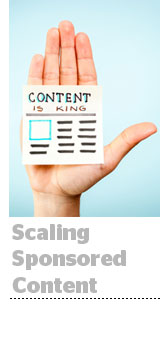
Despite rising content marketing budgets, the logistics of briefing multiple publishers, approving content and measuring results makes it difficult to scale investments.
To help brands and agencies address this logistical pain point, Pressboard designed a platform to automate, standardize and scale sponsored content. The company has helped clients such as GE, Ford, General Mills and Chase create 1,200 stories since it launched in 2014 in Vancouver, Canada.
At OMD, sponsored content serves as a critical touchpoint on the path to purchase that was once filled by public relations and organic content.
“We saw a big gap between what we were doing in awareness messaging and our conversion play,” said Diana Walter, group director for digital at OMD. “The messages were very different from each other. There was nothing linking the two.”
The agency didn’t like the heavy lifting and inconsistencies involved in setting up sponsored content campaigns. Plus, many publishers wanted to charge for traffic drivers to content instead of content views, a big downside for the agency.
“There was no guarantee of views and no guarantee of the quality of content,” Walter said.
OMD’s Vancouver outpost began running its clients’ campaigns through Pressboard shortly after the company was founded. The agency gives Pressboard a budget and uses its workflow technology to communicate clients’ creative briefs and budgets to its 300 publisher partners. OMD pays for a guaranteed number of views, and Pressboard fulfills those views across different publishers as needed.
Pressboard’s platform also includes analytics technology to help agencies measure campaign performance in a standardized way. Since many OMD clients using Pressboard also use multitouch attribution, Walter likes that they can easily place their DoubleClick Floodlight conversion tag within a Pressboard tag on every piece of sponsored content, simplifying the tracking setup.
OMD will still occasionally run campaigns outside of Pressboard, but it prefers to run campaigns through the provider because it offers “content at scale,” Walter said. And the company will even go out and recruit new publishers – such as finding skiing publications for a campaign about après-ski – if OMD needs a different publisher mix for a specific campaign.
“When we do brand-lift studies, we notice there is a significant lift in purchase consideration and awareness with the addition of content,” Walter said. “Content allows us to talk more about the nuances and points of differentiation versus a 30-second video or banner ad.”
Co-founder Jerrid Grimm came up with the idea for Pressboard while he was still working at an agency. A branded content campaign for a client, though successful, took 250 hours to plan.
“I had to hire an assistant just for one branded content campaign with four publishers. But the clients loved it,” he said.
In 2014, Grimm paired up with Tiam Korki, the CTO of Gauge Mobile who left after its acquisition by Juice Mobile. Their idea was build technology to make sponsored content faster to execute – 30 hours instead of 250 hours for a campaign.
“Programmatic is really efficient,” Grimm said. “Search and even TV are efficient, but branded content requires separate negotiations. There was no standardization in cost, measurement of how the transaction was built. You have to redo everything every time you did something as a publisher.”
Pressboard’s technology includes an analytics platform that took six months of development work to build and workflow software to communicate with publishers.
In June, Pressboard raised $2 million to add AI to its platform to predict the success of sponsored content.
Publishers in its network, including Business Insider, Vox and Thrillist, like working with Pressboard because it pre-approves them and gives them a budget right away, which lowers their costs, Grimm said. When publishers work directly with a brand or agency, they often have to respond to multiple RFPs just to win one sponsored content campaign.
Pressboard is paid a percentage of the media it helps place when it runs campaigns for clients like OMD. It also licenses its platform via a SaaS model with other agencies. The company has been profitable since launch, Grimm said.
In addition to using its funding to add AI technology to its platform, Pressboard is expanding its presence in New York, where the potential market is 30 times larger than in Canada.
This post was syndicated from Ad Exchanger.

More Stories
Deep Blue Is Building a Women’s Sports Yacht Club at Cannes
Sinclair SVP of Station Operations to Retire in June
Netflix Sets Up Killer You Marketing Activation With Penn Badgley